Jammu and Kashmir Backgrounder
Since 1989, the low-intensity conflict in Jammu and Kashmir (J&K)
has been the most important issue in India's internal security scenario.
Possession of the State has been an issue of dispute between India and
Pakistan since 1947. After two unsuccessful attempts to seize the territory
by force (1947 & 1965), Pakistan has largely refrained from making
any direct attempt at challenging control in the area of J&K still
in India's possession. Rather, the focus of Pakistan's efforts, channelled
through the Inter Services Intelligence (ISI), is on aiding Pakistan-based
militant groups who are waging a proxy war against Indian security forces
in the State. With the two countries
going overtly nuclear in 1999, the issue is also percieved globally
as a nuclear flash point.
The proxy war has claimed 26226 lives between 1988 and 2000 in an estimated
43956 incidents of terrorist violence. Of these casualties 10310 (40
per cent) were civilians, 3520 (13 per cent) were security forces personnel,
and 12396 (47 per cent) terrorists.
The emergence of the protracted insurgency in J&K, which began
with two explosions in 1988 (in Srinagar, the State capital), coincides
with the withdrawal of Soviet forces from Afghanistan. The insurgency
was preceded by a long phase of political turmoil in the State, which
began after the death of Sheikh Abdullah, the then Chief Minister, in
1982. Political squabbles between the National Conference (NC, the dominant
political outfit in the State) and the Congress government at the Centre,
saw the dismissal of two State governments. While Farooq Abdullah's
(Sheikh Abdullah's son) government was dismissed in 1984, the successor
Ghulam Mohammad Shah government was dismissed in 1986.
In the same year, the then Prime Minister, Rajiv Gandhi, concluded
an Accord with Farooq Abullah under which the Congress and the NC formed
an alliance to contest the State Assembly elections held in 1987. The
alliance won and Farooq Abdullah was once again sworn in as Chief Minister
of the State. The Congress-NC alliance was opposed, in the 1987 elections,
by a coalition of Islamic parties, the United Muslim Front. Allegations
of rigging in these elections gained wide credibility and generated
domestic unrest in the State.
Pakistan set out to channelise this civilian discontent into an armed
insurgency against India. Pakistan had successfully aided and abetted
the Jihad against the Soviet presence in Afghanistan by arming
and training the Afghan mujahiddeen. Several training camps were
now set up on the same model for disaffected elements who were willing
to take up arms against India's control in J&K. The ISI initially
used the Jammu and Kashmir Liberation Front (JKLF) in this effort. The
JKLF, formed in 1965, was originally a Pakistan-based militant outfit
committed to challenge India's control over the State. This organisation
was used to bring militant youth of the State, train them and send them
back to forment insurgency.
JKLF was the first militant group to advocate secession of J&K
from India. From the time of its inception till 1988, the JKLF focussed
on propagating its secessionist cause, and building its militant base
through indoctrination and arms training. A co-founder of the JKLF,
Maqbool Butt, was arrested and sentenced to death for the murder of
an Indian intelligence operative. In an attempt to secure his release,
JKLF activists, in early 1984, kidnapped an Indian diplomat posted in
London, Ravindra Mahtre. Mahtre was executed when the release demand
was not met. Maqbool Butt was hanged in February 1984.
While several minor incidents occurred in the second half of the Eighties,
insurgency began with two bomb blasts triggered by the JKLF in Srinagar
during the evening of July 31, 1988. In late 1989, Dr Rubaiya Sayeed,
daughter of the then Union Home Minister Mufti Mohammad Sayeed, was
kidnapped and the release of some militants was demanded. The government
succumbed to pressure, and the militants were released. This incident
gave a new confidence to the militants and an enormous impetus to the
their movement. The Union government in 1989, re-appointed Jagmohan
(a retired bureaucrat and former governor of the State in the first
half of the eighties) as governor of the State. Several public protests
during this period led to police firing which claimed several lives.
These incidents increased the anti-state fervour within sections of
the population and encouraged insurgency.
JKLF was initially used by the ISI, as it was the only established
militant group in Kashmir. The State in Pakistan had serious differences
with JKLF as the outfit was committed to J&K's independence rather
than accession to Pakistan. Pakistan recognised that the element of
Kashmiriyat, the spirit of independence among sections of the
state and JKLF, had to be countered with Islamic nationalism which could
be subsequently subsumed into Pakistani nationalism.
Between August 1988 and end 1989, JKLF was the only organisation involved
in the insurgency. Later, the ISI facilitated the formation and promotion
of various other militant groups (the number of militant organisations
had reached three figures by 1992). Prominent groups included the Hizb-ul
Mujahideen (militant wing of the Islamic organisation Jamat-e-Islami),
Harkat-ul-Ansar
and Lashkar-e-Toiba.
Unlike the JKLF which favoured independence for the state, these organisations
were more adaptable to the pan-Islamic Pakistani nationalism being promoted
by Pakistan.
With Pakistani material aid and indoctrinated cadre drawn largely from
the madarssas of Pakistan and Afghanistan, pro-Pakistan militant groups
grew very effective during the early nineties as the statistics on civilian
casualties indicates. Since 1994 there has been increasing evidence
of foreign militants participating and dominating the insurgency in
J&K. Meanwhile, devoid of Pakistani support, the JKLF stagnated
into an ineffective militant organisation focussing on other means to
propagate its aims. The influx of foreign mercenaries prompted several
local mercenaries to break ranks, in the mid-1990s, and aid Indian security
forces against the militants.
Insurgency was first predominant in the Srinagar Valley, particularly
when militants were largely Kashmiri youth. Indian Intelligence reports
indicate that two major developments motivated a change in strategy,
whereby the ISI-controlled militancy gradually shifted from the Valley
to the Jammu region. First, the resumption of a democratic government
led by Farooq Abdullah took office in 1996. The restoration of democratic
governance in the State helped in reducing dissatisfaction within the
people of the State and consequently popular support for the insurgency
in the Valley. Second, increasing availability of foreign militants,
indoctrinated in Islamic orthodoxy, facilitated a strategy of targeting
minority groups for massacres. The minority groups in the State are
largely concentrated in Jammu. These indoctrinated militants, fighting
their version of Jihad, had no qualms about indulging in massacres
of civilians of minority groups, particularly Hindus. The broad aim
was ethnic cleansing of the State. Several such massacres have been
perpetrated with Sikhs being a new target as witnessed in Chattisinghpora,
Anantnag district where 35 Sikhs were massacred on March 20, 2000 and
later at Mehjoor Nagar in Srinagar where six Sikhs were killed on February
3, 2001.
Massacres by J&K Militants
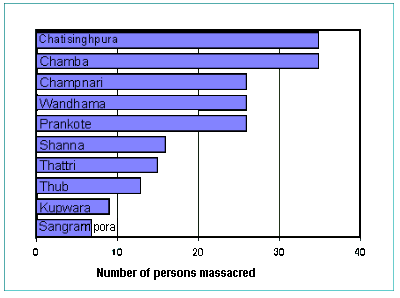
(Click on graph for data)
The first few years of insurgency (till 1992) saw a relative domination
of the terrorist groups when the casualties were mainly civilian. Since
than Indian security forces have been gaining an upper hand in eliminating
terrorists though civilian casualties continued to mount. The constant
supply of terrorists generated from religious institutions in Pakistan
and Afghanistan has helped keep up terrorist violence despite the fact
that each year Indian security forces have succeeded in eliminating
a substantial number of terrorists.
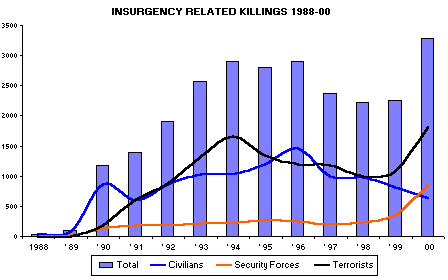
(Click on graph for data)
The impact of insurgency in J&K has been felt most by the civilian
population. Human casualty is one consequence, refugee generation and
economic stagnation are the others. The main economic activity in the
state, tourism, has been badly hit by terrorism. Narco trafficking,
indulged in by the terrorists to finance their operations too has been
an unwelcome consequence. The media too had to suffer from terrorist
violence. Several
mediapersons were killed and injured in this conflict.
Insurgency in the State, which has a Muslim majority, has been given
a communal image partly due to the media focus on massacres perpetrated
by militants. Lost in this sensationalism is the brutal reality that
the brunt of civilian casualties in this conflict has been borne by
the majority community.
Religious identity of civilian casualties in J&K
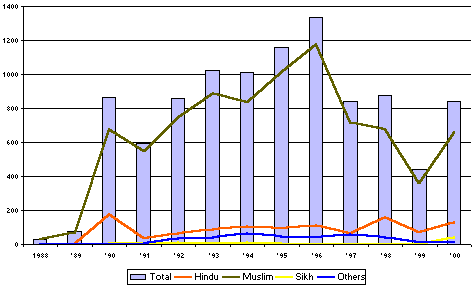
(Click on graph for data)
The present phase of insurgency is the most threatening attempt by
Pakistan among the various proxy war strategies it has used to seize
the state. After the first two unsuccessful attempts, which led to open
war between the two countries, Pakistan has been careful to ensure that
this phase of insurgency too does not flare up into an open war. The
situation came close to a war in June 1999 when Pakistan army regulars
were detected holding positions in peaks west of the Line of Control
(LoC) in the Kargil region and warding off attempts by Indian forces
to reclaim these peaks. India's restraint and US intervention during
July-August 1999, ensured a withdrawal of Pakistani forces and prevented
an open war.
The nature of arms and ammunition being seized from the militants in
the State indicates that the focus of insurgency has been gradually
shifting from selective killings to generating an atmosphere of terror
in the State through bomb explosions.The quantity of RDX seized by security
forces has risen from 104 kg in 1996 to 1280 in 2000 (untill November
15).
Weapon seizures
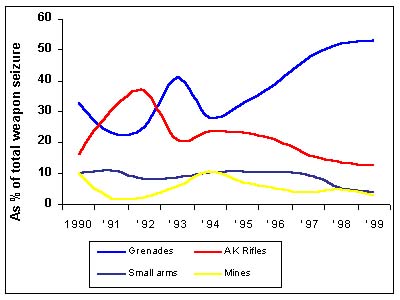
(Click on graph for data)
Explosives Seizures
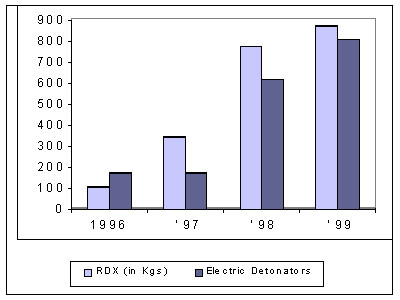
(Click on graph for data)
In its attempt to infiltrate trained insurgents across the LoC, a continuos
artillery barrage has been used by Pakistan as cover fire for infiltrators.
This has made areas near the LoC vulnerable to random shelling and forced
people to move from these areas. Substantial segments of the Kashmiri
Pundit community (which has been targeted by some of the terrorist groups
for attacks and massacres) too have migrated from the Valley and are
refugees in other parts of the State and in other States.
There have been several dramatic actions taken by militant groups in
the decade long insurgency. In July 1995, six foreign tourists were
abducted by a relatively unknown militant group, the Al-Faran.
The abductors demanded release of twenty-one detained militants, principally
top members of the militant group, Harkat-al-Ansar. The mutilated
body of one hostage, a Norwegian, was recovered a month later; the fate
of other hostages is not known to date. The December 1999 hijacking
of IC 814 too was directed at obtaining the release of top militants,
an action which was largely successful. The Al-Faran was believed
to be behind the hijacking.
In an attempt to escape from security forces in May 1995, militants
led by Mast Gul holed themselves in a Sufi shrine in the town of Charar-e
Sharief. After a two month siege, the shrine was destroyed by a fire
which burned most of the town too and led to cancellation of the government's
plan to hold elections.
Counter-insurgency operations have led to several instance where innocent
civilians have fallen victim to the bullets of the security forces.
In the initial stages of the conflict, security forces have had to resort
to firing when several mass protest demonstrations turned violent leading
to high casualties in police firing. Prominent among these are the cases
of firings Bij Behara (October 1993, 60 killed), Sopore (January 1993,
40 killed) and Srinagar (January 20, 1990, 35 killed). On April 5, 2000,
protestors in Brakpora, Anantnag too were fired upon by security forces
leaving seven dead. In a recent incident on February 16 at Haigam, Sopore,
five civilians were killed when a passing army convoy, which was blocked
by a protesting mob opened fire. The quick response of State authorities
in these cases, has reflected a new responsive attitude of the State
administration. The State government had released the inquiry reports
into the Pathribal firing promptly and promised action against security
personnel found guilty. An inquiry by a sitting High Court judge into
the Maisuma firing too has been ordered.
The February 1999 visit of the Indian Prime Minister to Lahore and
the subsequent Lahore declaration had generated expectations that there
would be some let down in the terrorist pressure. In contrast, the Kargil
episode has only intensified terrorist violence, particularly increasing
incidences of suicide attacks on bases of security forces. This has
translated into a rising proportion of casualties among the security
forces in the total casualties of the conflict.
Several initiatives have been taken by the government to settle the
problem. While the early nineties was marked by an excessive reliance
on security forces, several political steps were taken in the later
years. In a move to initiate the political process in 1994, the then
Prime Minister Narasimha Rao ordered the release of some militant leaders
like Yasin Malik and Shabir Shah. The democratic process was revived
first in April 1996 when elections were held to the six parliament seats
from the state. In September 1996 elections were held to the state assembly
where the National Conference won a majority and formed the government
under the chief ministership of Dr. Farooq Abdullah. The elections have
been marked by terrorist violence in a bid to disrupt the democratic
process.
Several economic initiatives too have been taken by the government.
These are aimed at addressing the lack of socio-economic development
in the State. The Central government declared J&K as a backward
state under the new industrial policy in 1995 to encourage new industries
and generate employment opportunities. This was followed by the announcement
of a Rs. 7200 crore ( US $ 1714.28 million ) economic package to the
State in February 1997. Following complaints of human rights violations
by security forces, the State government set up a State Human Rights
Commission in January 1997.
Prime Minister Atal Bihari Vajpayee took a major peace
initiative on November 14 when he announced that security forces would
observe a unilateral cease-fire during the holy Islamic month of Ramadan
begining November 27. This was subsequently extended twice for one month
each and a third extension for three months was announced on February
22. The unilateral cessation of hostility being observed by security
forces in the State would be in force until May 27.
This peace initiative did elicit some favourable responses
but failed to evoke any positive reaction from the main source of the
problem, indigenous and foreign terrorists who have converted the insurgency
into a profitable enterprise. Even as the secessionist All Party Hurriyat
Conference welcomed the government's cease-fire and expressed the hope
that it would be converted into a comprehensive cease-fire, terrorist
outfits under the umbrella of the Pakistan based Muttahida Jehad Council
(MJC) rejected the cease-fire in words and action.
Several major incidents of violence such as massacres
(two instances in Doda district on November 21 and 23, 2000 in which
10 civilians were killed; on February 3 in Srinagar where six Sikhs
were killed and on February 10 in Rajouri district where fifteen civilians
were killed), attacks
on security forces (nine personnel killed in two landmine
explosions in Rajouri on January 18, 2001) including suicide attacks
(at Srinagar airport on January 7 and 16, 2001 and the Army Headquarters
in Srinagar on December 25, 2000) and storming bases (in Rajouri on
December 16 and the Red Fort in New Delhi on December 22, 2000) marked
the terrorist response.
In contrast, the response from overground secessionist
forces has been encouraging though a huge gap still exists between their
demands and what the government is prepared to concede. The most positive
impact has been the explicit distancing of most Hurriyat leaders from
the terrorist outfits, especially those dominated by foreign merceanaries,
that operate in the State. This was most evident fromt the observations
made by leaders such as Abdul Lone and the Hurriyat Chairman Abdul Ghani
Bhat against foreign mercenaries. The Hurriyat has also given up its
insistence on trilateral negotiations between the governments of India,
Pakistan and the Hurriyat and has instead proposed bilateral dialogue
between the Hurriyat and the two respective governments. There is also
a proposal for a Pakistan visit by a Hurriyat delegation to hold talks
with terrorist outfits based in that country.
As is evident from the present situation in the State,
insurgency is far from being brought under control. The mere installation
of a democratically elected regime in the State or a cease-fire by security
forces has not helped the restoration process and the annual casualty
rates are considerably high. Efforts to isolate Pakistan in the international
community, for its sponsorship of terrorism in the State, have yet to
yield significant results. The proxy war in the State gained prominence
in the international agenda after the 1998 nuclear tests, the 1999 Kargil
flare-up, and the IC 814 hijacking
in 1999. Kashmir figured prominently in the US President's agenda during
his South Asian visit in March 2000 where he reiterated the futility
of force and interventions across the LoC as a solution to the crisis.
As expected, Pakistan has refused to commit itself to the principles
of peaceful resolution. Terrorist outfits active in J&K and based
in Pakistan continue to raise finance and operate training camps within
that country. The recent explicit outburst by these outfits against
Interior Minister Moinuddin Hyder's directive to prohibit fund raising
by jehadi groups, demonstrates their power vis-a-vis the State.
Military ruler Gen. Pervez Musharraf continues to publicly back these
terrorist outfits. Hence the scenario of conflict is likely to continue.
RELATED LINKS
|





